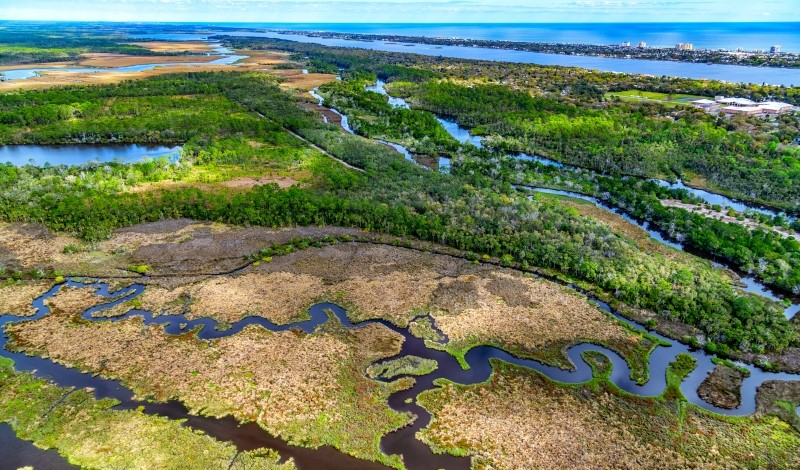
Rejecting federal agencies’ interpretation of the Clean Water Act, the Supreme Court limits the application of federal law over wetlands.
With its decision in Sackett v. EPA, the U.S. Supreme Court in May limited the application of the Clean Water Act (CWA) over wetlands, effectively weakening water quality protection legislation while simultaneously foreshadowing a demise of Chevron deference.
Substantially revised and restructured in 1972, the CWA was a result of a disastrous environmental decade that notably included the Santa Barbara offshore oil spill and the polluted Cuyahoga River catching fire several times. The CWA ensured that the previously voluntary state water quality standards would have a mandatory federal backstop if states refused to set them. It established permit programs to regulate discharges of pollutants into oceans and “navigable waters,” which include the undefined, enigmatic, and litigation-breeding “waters of the United States”—or WOTUS.
Charged with enforcing the CWA, both the U.S. Environmental Protection Agency (EPA) and the U.S. Army Corps of Engineers have finalized various regulations under Title 40 and Title 33 of the CWA. Importantly, since the mid-1970s, these regulations have defined what counts as a water of the United States. The agencies settled on a common (and broad) regulatory definition in the 1980s, which continues to operate as the default regulatory definition—albeit, as modified by the Supreme Court starting in 2001.
Two historic disputes over the definition of WOTUS are especially relevant to Sackett. The first dispute centered on adjacent wetlands. Prior to Sackett, the definion of WOTUS included certain adjacent wetlands, where the agencies expansively defined “adjacent” as “bordering, contiguous, or neighboring.” In 1985, the Supreme Court upheld this approach in U.S. v. Riverside Bayview Homes, Inc., deeming the CWA’s extension to adjacent wetlands necessary to fulfill the CWA’s broader water quality purposes and deferring to the two agencies’ expertise.
A second dispute at the core of Sackett related to four justices’ concern for private property owners and the entire Court’s debate over the importance of “navigable waters” in the Supreme Court’s 2006 split decision, Rapanos v. United States. In this case, petitioner John Rapanos argued that the CWA did not apply to wetlands that were not immediately adjacent to navigable waters. The wetlands in question were near ditches or artificial drains that eventually emptied via tributaries into navigable waters, over eleven miles away. Four justices, in a plurality opinion authored by Justice Antonin Scalia, decided that CWA protection was limited to either “relatively permanent, standing or continously flowing bodies of water” that are connected to navigable waters, or to “wetlands with a continuous surface connection to” the relatively permanent waters.
Justice Anthony Kennedy concurred with the plurality’s judgment that the agencies and lower courts employed the wrong test. However, he authored a separate opinion and introduced a different test, leading to an ongoing conflict over WOTUS tests that Sackett now resolves. Kennedy disagreed with the plurality’s interpretation of the CWA and instead followed the Court’s 2001 holding in Solid Waste Agency of Northern Cook Cty. v. Army Corps of Engineers (SWANCC). Under SWANCC, the Court decided “that to constitute ‘navigable waters’ under the CWA, a water or wetland must possess a ‘significant nexus’ to waters that are or were navigable in fact or that could reasonably be so made.”
In Rapanos, Kennedy embraced the significant nexus test, which expressly emphasized the biological and natural connections between water. After all, as Kennedy observed, “wetlands are not simply moist patches of earth.” These landscapes are defined by their varied interactions and ecosystems, yet they are difficult to define because of their biological diversity and often unique environmental characteristics. As any ecologist or hydrologist knows, wetlands and water systems do not operate in the neat and separate silos so often favored by law—they are chaotic, complex, and correlated.
Following Rapanos, both the George W. Bush and Obama Administrations used Kennedy’s test. Federal Courts of Appeals that addressed the issue also adopted at least Justice Kennedy’s significant nexus test, although they were split as to whether it should be the sole allowable test or if the Rapanos dissent’s approach should apply where a water qualified as WOTUS if it met either the Justice Scalia or the Justice Kennedy test.
In 2015, under the Obama Administration, EPA and the Corps finalized a rule that, in part, codified Kennedy’s significant nexus test into law. Under the Trump Administration, though, those same agencies issued the so-called Navigable Waters Protection Rule, which largely conformed to Scalia’s WOTUS test from Rapanos. In 2021, under the Biden Administration, EPA declared it would repeal the Trump-era rule. In early 2023, EPA and the Corps finalized new regulations that used Scalia’s Rapanos test but interwove the significant nexus test throughout.
With this history in place, we arrive at Sackett.
In 2004, petitioners Michael and Chantell Sackett began backfilling their lot near Priest Lake, Idaho, seeking to build a home. EPA informed the Sacketts that, because their property contained wetlands, the backfilling violated the CWA in the absence of a CWA permit granted by the Corps. EPA demanded that the Sacketts restore the site or face penalties of up to $40,000 per day. EPA classifed the wetlands on the Sacketts’ property as waters covered by the CWA based on the significant nexus test: the site was near a ditch that fed into a creek, which fed into Priest Lake, which is a navigable, intrastate lake. The destruction of wetlands would affect the physical, chemical, and biological functioning of the law.
The Sacketts disagreed with the EPA’s classification of part of their property as wetlands. The couple sued and continued to fight EPA’s designation for over fifteen years. On the Sacketts’ first trip to the Supreme Court in 2012, the Court unanimously decided that EPA’s and the Corps’s jurisdictional determinations—about wetland classifications—were final agency actions that could be challenged in court immediately.
The 2023 Sackett decision arises from the remand to, and the subsequent decision on the merits by, the U.S. District Court for the District of Idaho. At first, the Sacketts were unsuccessful. The district court sided with EPA. The U.S. Court of Appeals for the Ninth Circuit, applying Kennedy’s test in Rapanos, affirmed the lower court’s decision, “holding that the CWA covers wetlands with an ecologically significant nexus to traditional navigable waters and that the Sacketts’ wetlands satisfy that standard.”
This past May, however, the Supreme Court unanimously reversed—albeit with some differences of opinion among the justices.
Justice Samuel Alito, writing for the majority, rejected Kennedy’s significant nexus and adopted Scalia’s “relatively permanent” test from Rapanos:
We conclude that the Rapanos plurality was correct: the CWA’s use of “waters” encompasses “only those relatively permanent, standing or continuously flowing bodies of water “forming geographical features” that are described in ordinary parlance as “streams, oceans, rivers, and lakes.”
Instead of following decades of established scientific research demonstrating the breadth and complexity of aquatic ecosystems and wetland environments, the Alito majority embraced a definition that cited Webster’s New International Dictionary—a 1954 edition, no less. Even though most elementary school children learn the water cycle as a series of flows—many of them not visible to human sight—the Sackett Court upheld the antiquated and scientifically incorrect notion that the CWA applies only to those wetlands with a visible and continuous surface connection to a larger body of water.
Perhaps the Court was unaware that the U.S. Geological Survey recently updated its water cycle diagram. According to the Geological Survey, the newest version of the water cycle “brings humans into the picture, showing the water cycle as a complex interplay of small, interconnected cycles that people interact with and influence, rather than one big circle.”
As Sackett makes clear, however, legal decisions about water quality are not necessarily based on scientific realities. One possible explanation for the neglect of science may be that generalist judges’ reliance on traditional statutory and regulatory interpretation rules limits their ability to consider scientific knowledge when examining science-based rules. Therefore, there is a tendency to cite dictionaries and discuss the admittedly important difference between words such as “adjacent” and “adjoining,” as Justice Brett Kavanaugh did in a concurring opinion joined by Justices Sonia Sotomayor, Elena Kagan, and Ketanji Brown Jackson.
Another possibility is that at least five of the justices had priorities that conflicted with comprehensive protection of water quality. For Justice Alito’s majority, one of those priorities was protecting private property owners from the specter of heavy fines and potential criminal liability. For the majority, and especially for Justice Thomas, who authored a concurring opinion joined by Justice Neil Gorsuch, rejecting the significant nexus test also represented rejecting federal agency overreach. Indeed, Justice Thomas proffered a new and very limited vision of Congress’s Commerce Clause authority to regulate the nation’s waterways that, he argued, inherently limited EPA’s and the Corps’ delegated authority in the CWA.
Justice Kagan’s concurring opinion best identifies the Sackett majority’s erosion of judicial deference to both congressional intent and to the agencies’ statutory interpretations:
A court may, on occasion, apply a clear-statement rule to deal with statutory vagueness or ambiguity. But a court may not rewrite Congress’s plain instructions because they go further than preferred. That is what the majority does today in finding that the Clean Water Act excludes many wetlands (clearly) “adjacent” to covered waters. . . . “The Court substitutes its own ideas about policymaking for Congress’s. The Court will not allow the … Act to work as Congress instructed. The Court, rather than Congress, will decide how much regulation is too much.”
Despite the fact that all nine justices concurred in the judgment and rejected the significant nexus test, there were four separate opinions, and the Sackett decision creates several follow-on consequences and issues. For example, as noted, EPA and the Corps already finalized in March a WOTUS rule that incorporates the significant nexus standard. Following the Court’s decision in Sackett, the new regulation is fairly obviously invalid. However, it is unclear how the Biden Administration will proceed in the already-filed litigation challenging this recent regulation.
Another immediate issue is the protection of non-navigable wetlands, streams, and rivers. The continuous surface water connection test suggests that most relatively permanent tributaries are still protected—but intermittent waters have arguably lost federal protection. Regardless, the Court’s decision immediately limits federal authority to protect wetlands under the CWA. In many cases, states and Tribes already fill the federal gap, or may soon act to do so. But that will not be true everywhere.
Another open issue is how the Court’s 2020 jurisdiction-broadening decision in County of Maui v. Hawaii Wildlife Fund will potentially mitigate Sackett’s impact. County of Maui created a test under the CWA that requires a permit for any “functional equivalent” of point source pollution into navigable waters, broadening CWA jurisdiction.
The impact of Sackett, though, will be enormous, creating challenges that go beyond the protection of wetlands and water sources. Critically, Sackett follows West Virginia v. EPA as yet another decision by this Court that refuses to defer to an agency’s interpretation of the statutes it implements under a guise of requiring clear congressional authorization. If these cases are any portents, the future of Chevron deference looks bleak. Indeed, the Court has already announced that next term it will hear Loper Bright Enterprises v. Raimondo, where petitioners are explicitly asking the Court to overturn Chevron altogether.
This essay is a part of a nine-part series entitled The Supreme Court’s 2022-2023 Regulatory Term.





